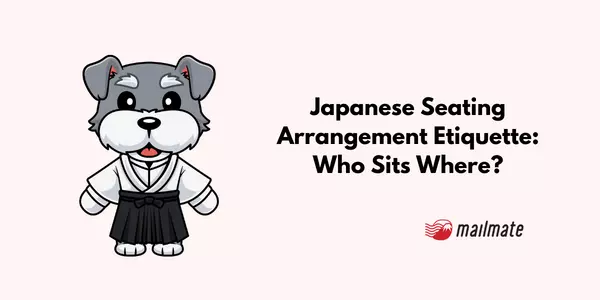Japanese Seating Arrangement Etiquette: Who Sits Where?

Feeling ready to expand your knowledge of Japanese business etiquette?
Do you have an upcoming meeting with Japanese clients? Perhaps you are pitching your service to a Japanese company? Or perhaps you want to know where to sit when meeting clients over business dinners?
In the previous article in this series on Japanese culture, you learned the secret to successful introductions with Japanese clients, and you are now ready to take your seats.
What should you know about seating arrangements in Japan to avoid offending your clients?
We take a look.
Seating arrangements when meeting with Japanese clients
In Japan, the seat farthest from the door, kamiza (上座), is reserved for the most senior individual. In a business setting, this would apply to the highest ranked executive on the client side.
The opposite of kamiza is the one closest to the door, reserved for the most junior in your team; this seat placement is referred to as shimoza (下座).
This long-held practice arises from the understanding that the seat farthest from the door is the calmest and should be reserved for senior ranked individuals. And the seats nearer to a room's entry are less quiet, more exposed to foot traffic, and are reserved for subordinates.
So, if two members of your team are visiting a prospective Japanese client's company, and you are shown into a reception room, follow this picture diagram to memorize who should sit where:

Image: Seating protocol for meeting with 2 Japanese clients (Kaigishitsu.com)
The highest ranked Japanese client will sit in the seat farthest from the door (Seat 1, kamiza) in a meeting room. His subordinate will sit next to him (Seat 2). And you (or the senior executive of your team) will sit facing the highest ranked client (Seat 3). Your subordinate (the lowest rank individual) will sit in the seat closest to the door (Seat 4, shimoza).
You might also find yourself in a room with a long sofa. By some ways of thinking, long sofas are considered more comfortable than single armchairs.

Image: Seating protocol for meeting with 2 Japanese clients and a long sofa (Kaigishitsu.com)
If you come across a room format with 2 single sofas + a long sofa, the most senior person will be in the seat farthest from the door (Seat 1). His subordinate will sit next to him (Seat 2) on the long sofa. And you will sit facing the highest-ranked client with your subordinate next to you (Seat 4, the seat closest to the door).
There is one exception to this order. If artwork or a large window with a scenic view is located on the side farthest from the door, then the kamiza seat is the seat that can best appreciate this view.

Image: Seating protocol when there’s artwork on display (Source: Essam)
Additionally, if there are a number of individuals on the client side who will be involved in the meeting, you might find yourself in a conference room with a long table down the middle.

Image: Seating protocol for meeting with several Japanese clients in a conference-style room (Source: Essam)
In this case, the person of senior rank on the prospective client side will sit in the center chair (farthest from the door), with Seats 2 and 3 for members of his team in order of rank. You will sit directly across from the senior client (center seat closer to the door), with Seats 2 and 3 occupied by your team in order of rank.
Seating arrangements when sharing a taxi with Japanese clients
If you share a taxi or a private car with your client, the kamiza is the window seat directly behind the taxi driver. Your client's subordinate will sit in the seat nearest to the other passenger door (Seat 2), you will be in the middle of the passenger seat (Seat 3), and your subordinate to the driver's left (Seat 4).

Image: Seating protocol when riding in a taxi with Japanese clients (Kaigishitsu.com)
If you are uncomfortable in small spaces, arrange separate forms of transportation when going to a destination.
Elevator protocol with Japanese clients
In an elevator, the kamiza is the position at the back left-hand side. This is helpful to know when accompanying clients to a destination or when walking them through your company’s premises.

Image: Protocol when using an elevator with Japanese clients (Kaigishitsu.com)
Note: Positions 3 and 4 might be reversed, depending on which side the elevator’s panels appear. The most junior position (4) would handle the elevator’s operating buttons.

Occasionally, seating protocol will get ignored. And if your Japanese clients are used to interacting with non-Japanese executives, they will probably be gracious.
However, if you are looking to master Japanese business etiquette, following seating protocol in Japan will show you care about the little things—and give you a touch of class that your Japanese clients will appreciate.
Frequently asked questions
What is sekiji?
In Japan, there is an unspoken rule about where to sit when you are in the company of your elders, co-workers, and customers. The seating or standing arrangement in Japanese business is called 席次 (せきじ - sekiji).
Who sits where in Japanese meetings?
While there are many details to Japanese seating etiquette, the most important is that the guest-of-honor is seated farthest from the door.
In closing
Occasionally, seating protocol will get ignored. And if your Japanese clients are used to interacting with non-Japanese executives, they will probably be gracious.
However, if you are looking to master Japanese business etiquette, following seating protocol in Japan will show you care about the little things—and give you a touch of class that your Japanese clients will appreciate.
Spending too long figuring out your Japanese mail?
Virtual mail + translation services start at 3800 per month. 30-day money-back guarantee.

